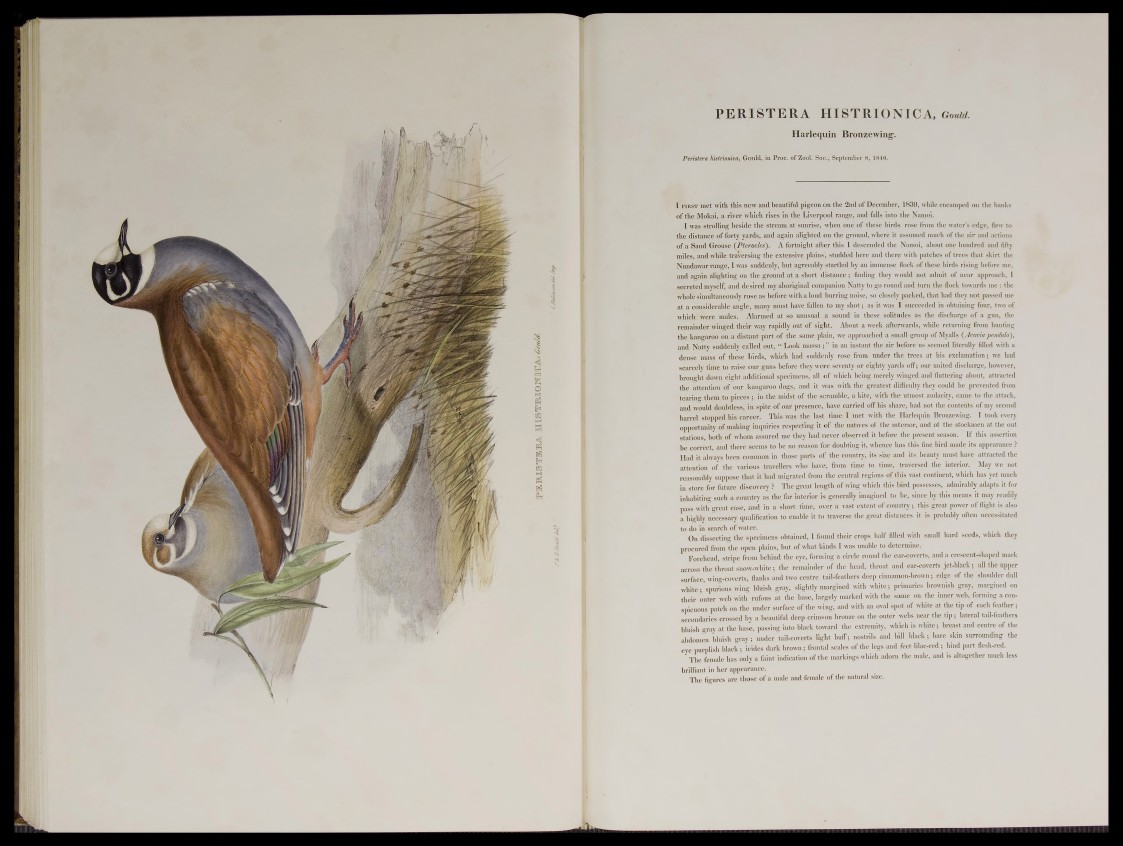
HE M S T K 1R A U J c B M M O
PERfFTERA HISTRIONIC A, Gould.
Harlequin Bronzewing.
Peristera histrionica, Gould, in Proc. of Zoo}. Soe., September 8, 1840.
I first met with this new and heajitiful pigeon on the 2nd of December, 1839, while encamped on the banks
which range. ’«id falls into the Namoi.
I was strolling beside th( -trean^at. -unci'i\ ’.hen one of these birds rose from the water’s edge, flew to
the distance ofsfbrtv yards, and again alighted on the ground. Where it assumed much of the air and actions
of a Sand Grouse (Ptarocles). A fortnight after this I descended the Namoii about one hundred and fifty
miles, anetwhila traversing the CXtSjMyS plains', studded here and therewith patches of trees that shirt the
Nundawar range, I was suddenly, b.ut agreeably startled, f e a o immense flock of tbsggliirds rising before me,
on the gmmiLat a short distance; Sfnclng thuslwoultliy^adniir ut near approach. I
secreted myself, aijd desireil’mjjdmpgiud cqmpani'm Natry ty'gijfr(njy®mffltuja! jhifflock towards pie: the
whnicsmiiihineously rn-i is hUotonytlf ihind hinangfUCij-i, so rloadwnaikidfrlhabhad1 theynqfopassedme
at a-considerable" angle,- many mustdnj.ve fallen to ijm'sfot; af*it..w.is T Vim-reeded in obtaining four, two of
whichwerc males. Alarmed at so unusualsa’ sound ip these solitudes as the discharge of a gun, the
rein aim b iLWing^J'lyjP wav’r ipidly out of sight. giVlnml. pweelni afterwards, while returning from hunting
the kangaroo o S if t^ f c t ip a r r of the sajne-plain, we a p p ro a c l^ a small gr6up of Myalls (Jcacia penduld),
and-Natty suddenly caUec&u^'Eook massa;" ajr before us seemed hterSlly filled with adense
mass of tb e s ^ h ttp T which had suddenly under the trees at his exclamation; we had
scarcely ^ m tp .r a i ^ o iM M S nefore they were si wyiu.or d r ill, yards off; our united discharge, however,
bi|>ug)s£down eight additfonal%eigmpnf!, ajl,pf which being merely winged and’fluttering about, attracted
the attention o^owJtaaggmo does, and it was, y q® the greatest difficulty thej coul^he prever&d from"
'W rin g thefe topie ce sj aufthe miils't-of.fthh.scramhle. a kite, with the utmost iudai iti^camcitg the attack.
- S i would doubtless, in spite, o f our presence, have carried qff%s shau, h id. not tin. i onftifts of my ercond
barrel stopped liSicIreiir This wps. tj>e lasj-.tiim I ion n uCw^yM rluiipjj^Hranar wuig 1 took every
opportunity of making i l f p i V ^ e o t i n g i t of the natives of t h ^ i p ^ S and of the stockmen at the out
aj UiouaT hobE of whom H liad never Obserred it before the-,presept se a sg j.^ If this assertion
1 oojrect, -andthere seems i f f « ri j-pn foSIjSStiftiainvvtu nee haeMiSfiil;bird made its appearance?
Had it always'been common'in those parts of thesgopnte, its size a n d } , m u s t have attracted the
atteptrap of the varipu^tovellers who have, f r | | |p D ^ t o tim ^ ,^ a v ew if the ^interior. May we not
reasonably suppose that ft had* migrated from tile «ciurahn gion? ***'«' “'f l& f ,wh" ll h’ls yet much
in slow tor.tifluri ili^< o.cry fp llu y g re a t length of w iip which this fp-d-possesses, admirably adapts it for
inhabi^g,such a. country as the fer interior is geneially m i a g u i i m e a n s it » ay r e a ^ >
pass with great u i’a''’shprt ti'^V oygfa vasf jptuSstwf country; this great power offl%ht is also
a hK ^ n e c e s s a ry qualification to enable it to traverpelae great distanoes’^ g p r o b a b ly often neeesritateft
to do in ’search of water.
On dissecting the specupeps ohtaidsdvl found their crops 'half 'filled .wit^stpall hard seed’s, which they
procured from the open plains, hut of what kinds I was u n a ljj^ d s te f & f f ’ ,
Forehead, stripe from^tfead'the eye, forming q -u n ji round tin.« ui jtm ijt , mda creacent*H®j£mark
across the throat snow-white ? the- reminde r o f the-head, tlnbat ^ d > > a r - c o y e r ^ e ^ ^ ly ,a ll the upper
surface wiug-oovejfts, flanks ahft<two centre .tail-feathers deep cirmanroprbrown^.^Je of the shoulder dnft
white 5 'spurious wing bluish gray, ”shgbtty margined with whife^grimaries margined on
their outer weh with rufous at the base, largely Marked with thg-same on t h f h ; i ^ ^ ® i , forming a con-
spicuous patch on the under surface of the wing, and with an oval spotgfr white;:a ^ g i i of each feather;
secondaries crossed by a beautiful deep 'crimson I p n z ^ ^ t b e outer webs near i lateral tail-feathers
hluish gray at the base, passing into black toward the e * t r < ® j t y ^ w h i c h i s a n d centre of the
abdomen hluish'gray 5 a n d « tail-eovsri^lght buff; nostrils and'bfll black ;’% • < skin surrounding the
eye purplish black; irides dark brown; frontal scales of the fegsja^ffeet lilac-red; hind part flesh-red.
' She female has only a feint indication ofi the markings which a |i j n the male, add is altogether much less
-brilliant in her appearance.
The figures are those of a male and female of %e naturai'she.